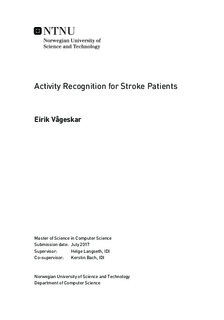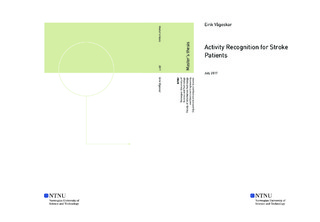| dc.description.abstract | Stroke is a disruption in the blood flow to the brain which may lead to a death of brain cells. More than 12000 Norwegians experience a stroke each year. Survivors often suffer lasting movement disabilities, which affect their ability to stay active and live independently. Knowledge about the time a patient spends performing certain activities in their daily life, as well the frequency and intensity with which they are performed, is useful for rehabilitation. Physical therapists can use this knowledge to adapt treatment plans to a patient s needs and abilities. Reports from larger groups of patients can be used to study the effects of new treatments.
Self-reporting and observation by a professional are the most common ways to acquire knowledge about how often and for how long a person performs different activities. These methods often lead to inaccurate results due to subjective errors and limited time respectively. Human activity recognition (HAR) systems are an alternative to these methods which is not prone to the same errors. Using machine learning techniques, these systems can recognize what activity a person performed at a given time. Measurements of the person s movements, made by one or more sensors worn on the body, are given to the system for it to perform its task. To learn how to perform this recognition, a HAR system must be trained on previous examples of such sensor recordings which have been labeled with what activity went on during each example. Because stroke patients move differently from healthy subjects, systems trained on examples from healthy subjects are inaccurate when recognizing the movements of stroke patients.
The goal of this thesis has been to create a HAR system which performs accurate activity recognition for stroke patients. This work has relied on a new data set collected from stroke patients. Fifteen stroke patients participated in the collection, wearing five three-axis accelerometer sensors, located on both wrists and thighs and the lower back. Hour-long recordings of the subjects were conducted in a laboratory, each subsequently labeled with the activities that the subject performed.
Experiments have involved using different combinations of accelerometers, classification techniques, training data sets, and amounts of training data, resulting in a classifier based on a random forests ensemble method. The final system is able to recognize the activities of stroke patients with 93.4% accuracy using one accelerometer on the lower back and one on the thigh. Using additional accelerometers on the thigh and wrist, the system achieves 94.6% accuracy. One of the final experiments shows that the system can be trained on a data set with examples from both healthy subjects and stroke subjects and still be equally accurate in recognizing activities for the subjects in both groups as classifiers targeting each group. This opens up the possibility of making HAR systems that are not tailored to specific patient groups, recognizing movements from both healthy subjects and subjects with different disabilities with the same accuracy as group-specific classifiers.
The work has involved performing a survey of relevant HAR literature regarding both healthy and disabled subjects. With a chapter devoted to the necessary background knowledge in addition to a literature survey, the thesis should serve as an introduction to accelerometer-based HAR for anyone with a background in computer science. | |

